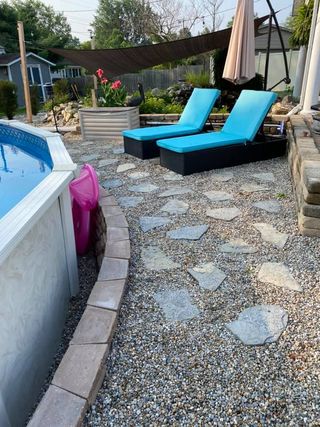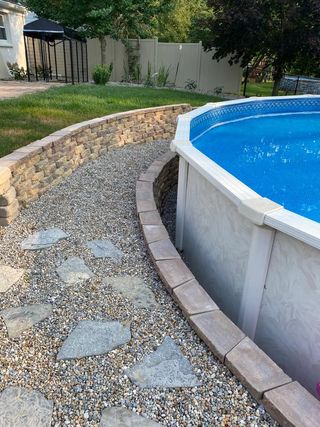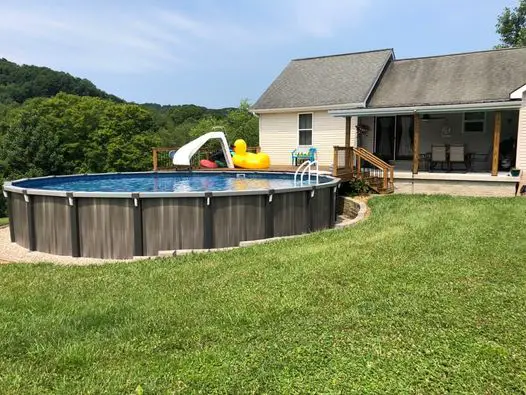Not all yards are flat enough to install an above-ground swimming pool directly on top of the ground. When a yard is sloped, then the pool has to go in the ground at least on one (high) side.
When this is needed, some will choose to build a retaining wall to keep the earth away from the pool’s wall.


When building a retaining wall for an above-ground pool, it’s usually best to make it before installing the pool, should be made to last, designed not to fail (cave in), and is at least one foot away from the pool’s wall.
TO BUILD A RETAINING WALL OR NOT. THAT IS THE QUESTION
For most above-ground pools installed in severely sloped backyards, a retaining wall is not needed. This may be good news for some who think one is absolutely necessary.
In truth, a retaining wall is only needed for a couple of specific situations. Most installs on sloped yards don’t need one.
WHY SOME THINK THEY NEED TO BUILD A RETAINING WALL FOR THEIR ABOVE-GROUND POOL
1. Not building one will void the pool’s warranty
Makers of many models of metal/hard-walled above-ground pools will recommend only going in the ground by a certain depth. A common depth is 24”-30” max.
If the pool is further in the ground than that, it will void the warranty of the pool. This is true, but only if the pool is more than 24”-30” in the ground ALL THE WAY AROUND.
Now, with a yard that is severely sloped, the ground (pool site) must be completely leveled in order for the pool to be level. This means that the high end of where the pool is going must be dug out some. This will leave the pool in the ground, but only on one side and not all the way around.
With this, half of the pool will be standing completely out of the ground. And that will NOT void the warranty.
2. Some think that the pool’s wall cannot have any earth/dirt resting against it.
In your defense, it is called an above-ground swimming pool. And so it would be logical to think that the pool cannot go into the ground at all. In reality though, they can.
An above-ground swimming pool can be installed all the way in the ground if you wanted to and it wouldn’t hurt anything as long as the pool is full of water. They do need to be emptied though when the liners have to be replaced, so that is why it’s not a good idea to put them completely in the ground.
When empty, a pool can cave in. This is why I only recommend going in the ground about halfway max.
3 Dirt/earth against the pool’s wall will cause it to rust
During the now 37 years of me working on and installing above grounds, I have found no proof that pools buried partially in the ground will rust. Some pools will rust and some won’t regardless of whether in the ground or not.
4. To prevent erosion from happening around the outside of the pool
Anytime there is an extreme slope in a yard, there is a possibility for erosion.
Now, erosion is where large amounts of rainwater form a temporary river and the moving water carries earth with it from the high side of the yard to the low side.
It’s important to note that erosion will not be prevented by a retaining wall. The water will still travel along the retaining wall instead of the pool’s wall.
This means steps have to be taken to prevent earth from traveling along the retaining wall. These same steps can be taken with the pool’s wall, which will work just as well and you won’t need the retaining wall.
5. They live in an area where the ground has “frost heaving”
This is a legitimate reason to want to keep an above-ground pool completely out of the ground. In the colder areas, the ground will freeze, then thaw, then freeze again.
When this happens and an above-ground pool is in the ground some, this condition can push the wall of the pool upward, which will make the pool off-level (not cool).

WHEN YOU MOST LIKELY DON’T NEED TO BUILD AN RETAINING WALL FOR YOUR ABOVE-GROUND POOL
In most cases, a retaining wall is not needed.
1. If you are going in the ground less than two feet on one side of the pool
A two-foot slope is considerable when installing an above-ground pool. This will mean that the pool will be two feet in the ground on the high side of the yard. From there, the pool will be less and less in the ground as it goes around the low side of the yard.
What I mean here is that maybe one-quarter of the pool will be two feet down, then half of the pool (at most) will be between two feet and a couple of inches in the ground, leaving the rest (low side of the yard) completely out of the ground.
With this, the odds of having a cave-in when the pool is empty (during a liner replacement only) is small, so an expensive time consuming retaining wall is not needed.
2 If the pool is sunk in the ground, but less than 18 inches.
Burying an above-ground pool partially in the ground is a very popular installation. Some will want it sunk in the ground more than two feet. And with that, the odds of a cave-in during a liner change increase considerably.
When only going in the ground a foot and a half or less though, it’s usually not a big risk of a cave-in during a liner change.
3 If your earth is really hard
Here in Central Florida where I install pools, most areas are sand-based. This means that the earth can be very loose and sandy, which is prime cave-in material.
If your earth is hard though, then the odds of the pool’s wall caving in during a liner change are very low. Earth made mostly of clay, large rocks, or excessive roots can make the earth against the pool’s wall very firm.
This firm earth will not move in or collapse when the pool is drained during a liner change. So, a retaining wall then is not needed.

WHEN A RETAINING WALL IS ABSOLUTELY NEEDED WITH AN ABOVE-GROUND POOL
Even though seasoned installers like me only recommend sinking a pool only halfway in the ground, some are insistent on putting one all the way in (four feet down).
In the case of someone wanting an above ground pool all the way in the ground, I recommend a retaining wall. This is the only way it can be guaranteed that the pool won’t cave in during a liner change some years down the road.
Now I work in Florida where it is sand-based. So, when someone inquires me to change a liner in an above-ground pool that is all the way in the ground and doesn’t have a retaining wall, I will turn the job down.
This is because the likelihood of me having a major issue with a cave-in is very high. And it’s not easy for me to say “Hey if the wall caves in, your pool is done AND you have to pay me for my time”. Yeah, I don’t want to be a part of that.
Now, if you live in an area where the earth is very hard, then it may be fine. Even here in Central Florida, there is some hard enough earth where there won’t be a cave-in with a pool completely in the ground.
The other instance when a retaining wall is recommended is if the ground has a potential for “frost heaving”. There are some ways to install the pool below the frost line and anchor it, but you will need a very experienced pool installer who knows what he is doing in terms of frost heaving prevention.
I say just play it safe and build a retaining wall if you have a potential for frost heaving. Period.
Another good reason to build a retaining wall is if you are sinking a soft-sided pool in the ground. These pools only last a year or two(on average), so replacing them when sunk in the ground WITHOUT a retaining wall every couple of years is not ideal.
THE DIFFERENT TYPES OF RETAINING WALLS MADE FOR ABOVE-GROUND POOLS

Contractors and companies that build retaining walls exclusively put a lot of planning, design, and expensive materials into making them. They have to do this because retaining walls can easily fail or not last long.
Some won’t completely fail, but will tilt, sag, or bulge. And to a retaining wall builder, this is a fail.
Fortunately, retaining walls made for above-ground pools don’t have to be and stay perfect for decades. They just have to do the job of holding at least most of the earth back away from the pool’s wall.
And they usually aren’t visible, so if they fail a little, it doesn’t matter much.
Now, if money wasn’t a consideration, then you would have a retaining wall specialist come and he would build a perfect and beautiful wall for thousands of dollars.
If you are looking to get it done (or do it yourself) on the cheaper side of things, then choosing how you will do it and what materials to use will be your first stage.
Over the past 37 years, these are the retaining walls that I have seen built.
A Built using concrete blocks and cement
B Built using sandbags and cement
C 4×4 PT(pressure treated) posts with 1×4, or 2×6, or 2×8 PT planks nailed horizontally to the posts
D Landscape timbers stacked, nailed together, and reinforced by vertical 4×4 posts
E 4×4 PT posts with marine grade plywood nailed to them
F Retaining walls blocks connected by design and reinforced by their design system (Pricey)
G Steel beams with corrugated steel sheeting screwed to them
RETAINING WALLS NOT DONE WELL WILL FAIL
I have seen my share of retaining walls built for above-ground pools fail. Usually, I see how they have held up when doing a liner change OR when replacing a pool.
Most that failed were made from wood that eventually rotted out and let the earth through. Some just tilted forward. They looked bad but still did the job of keeping the earth from laying heavily on the pool’s wall.
The good news here is that most retaining walls that failed were still doing the job of keeping the pool’s wall from having too much dirt pressing against it. This means that you don’t have to overbuild your retaining wall.
SOME BASICS FOR BUILDING A RETAINING WALL FOR AN ABOVE-GROUND POOL
I am by no means an expert retaining wall builder. I have built a few though for holding back the earth around above-ground pools AND have seen many of them years after they were built and how they failed.
Here are some of my recommendations.
1. Build the retaining wall BEFORE you install the pool
I can’t express to you how much easier it is to build the retaining wall first. Just make sure that you make plenty of room to install the pool later.
2. Build the retaining wall at least one foot away from where the pool is going
Trying to butt the retaining wall up to the pool is a bad idea for a couple of reasons. One, it’s good to have a buffer area between the pool and wall just in case it fails some.
The other is that you want that wall to be completely out of the way of the pool install. Installing in too tight of a spot invites issues.
3. Make sure the retaining wall has a greater radius than the pool
What I mean here is that most above-ground pools are round. Even oval pools have round ends. So, when building the retaining wall, make its circle(radius) bigger or wider than the pool’s radius.
This will prevent you from having an “Uh Oh” moment when you go the install the pool and find out that part of the end of the retaining wall is too close to where the pool is going.
The best way to do this is to layout where the pool is going using a tape measure. Find the middle of the pool, stick a screwdriver in the ground, and connect the tape measure to it.
As an example, if your pool is a 24’ round, measure out 12ft from the middle of where the pool is going and mark. That is where the pool’s wall will go.
Using the same middle reference, measure out at least 13.5ft and mark that in a circular shape. This can be where your retaining wall will go and ensure that the radius of the wall won’t run closer to the pool.
4. Vertically reinforce your retaining wall
It doesn’t matter whether you are using concrete blocks, simple wood planks, or plywood for your wall. You want to use something like 4×4 pressure-treated posts to keep the wall from tilting forward (towards where the pool is going).
Dig them down maybe two feet below the bottom of the retaining wall and bury them vertically against the wall. This will help stop the earth behind it from pushing the wall forward and failing.
5. If using wood, use pressure treated
Non-treated wood will rot in the ground much quicker than you think. I know it cost considerably more for pressure-treated wood, but you really have no choice.
6. You don’t have to overbuild this retaining wall
If it’s in your nature to overbuild, then be you. Research retaining walls and go crazy building something that will outlast your kids’ lifetime.
A retaining wall for an above-ground swimming pool though is commonly unseen as they are often under decks or on the backside of where the pool is accessed and used. They also can tilt and fail some and still be doing the job of holding back the earth from the pool’s wall.
Because of this, you don’t have to go crazy with your wall. Many will have some building materials that they have or can get cheap and want to use those for the wall. Do it.
I have seen some really crude retaining walls continue to 100% protect the above-ground pool they were made for. Just make sure it holds most of the earth back and won’t completely tilt into the pool.
And even if it does, it’ll probably still be ok as it only needs to work when the pool is empty, which is maybe once every few years or more.

